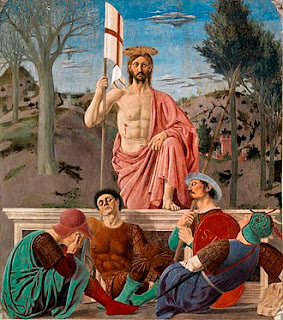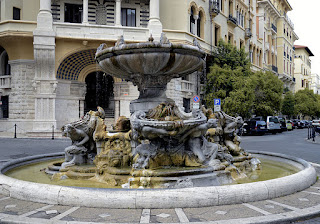Penultimate head of Most Serene Republic
 |
| The 1779 portrait of Renier, by Lodovico Gallina, hangs in Venice's Museo Correr |
After a long political career, Renier was already 69 years old when he was appointed as Doge in 1779, an advanced age to be taking up such a position. He was not a popular choice.
He was a skilled orator but seen by many as manipulative and opportunistic. By the time of his appointment, La Serenissima (the most serene) - as 'Repubblica di Venezia’was officially prefixed in medieval and Renaissance times - was in sharp decline, its strength as a military and trade power largely a thing of the past.
The Venetian nobility was riven with factionalism and there was widespread discontent among the ruling elite and the broader public. Renier is said to have received numerous threats, warning him against accepting the role.
He did not help his reputation by appearing to change his position on a number of issues once elected. Having previously aligned with reformist factions in the Venetian government, advocating for administrative and economic modernisation, once elected he shifted toward a more conservative stance, opposing many of the reforms he had once supported.
In doing so, Renier alienated both reformers and traditionalists, who saw him as untrustworthy or self-serving. Venice was desperate for an inspirational leader who could recreate the belief in future prosperity the city once enjoyed. Yet historians suggest that Renier's speeches, while polished, sometimes emphasised the Republic’s decline in a tone that bordered on defeatism, which did little to inspire confidence.
This was exemplified in a public speech he made in April 1780, in which he lamented Venice’s lack of military strength, alliances, and economic vitality, concluding that the Republic survived only by “chance and the prudence of its government.”
Paolo Renier was born into a patrician Venetian family prominent in the 16th and early 17th centuries. His father, Andrea, held numerous positions in the Venetian government, most prominently as a member of the Consiglio dei Sei, a panel of six officials who advised the Doge. Five of Paolo’s brothers also played a part in Venetian political life.
 |
| Renier was admired for his oratory but seen as an opportunist |
But, skilled in political manoeuvring, he acquired enemies along the way, as well as a feeling among many that he was a man who could not be trusted. When he was elected Doge on January 14, 1779 in the first ballot, with 40 votes out of 41, it was popularly rumoured that he had bought the election using the money earned in Constantinople.
In any event, as the 119th Doge of Venice, he inherited a state in decline at a time of public disillusionment with the Republic’s leadership im general. The once-mighty maritime republic had lost its dominance in Mediterranean trade and was increasingly marginalised in European politics. He faced a tide of decline that, despite his diplomatic experience and rhetorical prowess, he was ultimately unable to reverse.
Away from the political arena, Renier was twice married, first in 1733 to Giustina Donà, who died in 1751, and later Margherita Delmaz, who outlived him by nearly three decades, dying in 1817.
Despite the political turbulence of his reign, Renier remained a man of culture and intellect. It was said that he knew the Iliad and the Odyssey by heart and he was known to have translated works of Plato into Venetian, reflecting his humanist education and engagement with classical thought.
His tenure ended with his death in February 1789, from rheumatic fever, just months before the French Revolution would begin to reshape Europe. He was succeeded by Ludovico Manin, who would become the last Doge of Venice before Napoleon’s forces brought an end to the Republic in 1797.
 |
| The stunning Chiesa di San Stae opens on to the Grand Canal in the heart of Venice |
San Stae, where Paolo Renier was born, is part of the Santa Croce sestiere, a quieter, slightly less congested quarter of Venice compared with tourist-heavy San Marco. Nonetheless, it has some important attractions, not least the parish church, the Chiesa di San Stae. A stunning Baroque church on the Grand Canal, redesigned in the early 18th century by Domenico Rossi, its façade - facing the Grand Canal midway between Rialto and Santa Lucia railway terminus - combines regimented Palladian lines with some elaborate sculptural decoration. Inside, there are works by Tiepolo, Piazzetta, and Ricci. No more than two minutes’ walk from the church, walking away from the Grand Canal, the Palazzo Mocenigo houses a museum exploring Venetian fashion, perfume, and textiles. From there, it is just another three or four minutes to reach Campo San Giacomo da l’Orio, a peaceful square that has the authentic feel of residential Venice. The church from which the square takes its name is one of the oldest in the city, with a history going back to the 10th century.
Stay in Venice with Hotels.com
 |
| The pink Verona marble of the striking Doge's Palace is a prominent feature of the Venice waterfront |
Standing beside the Basilica di San Marco - St Mark’s - facing the Venetian lagoon to the south and the Biblioteca Marciana to the west, across the Piazzetta, the Doge’s Palace is one of the most striking sights in Venice. Built in Venetian Gothic style, with its open arcades, delicate stonework and pink Verona marble, the imposing palace dates back to around 810 and was the political and ceremonial heart of the Venetian Republic for over 1,000 years. The first structure was thought to have been a fortified building with towers, reflecting the Doge’s military and executive authority. It was rebuilt in the 14th century, under Doge Pietro Gradenigo, as an opulent palace to reflect Venice’s growing wealth and power. During its time as the seat of Venice’s government, the palace housed the Senate, the Council of Ten, and State Inquisitors, as well as the Hall of Justice and Archives. The city’s prison, including the infamous Piombi and Pozzi cells, was connected to the palace by the Bridge of Sighs, added in 1600, which came to symbolise the final view of Venice for condemned prisoners.
Let Expedia help you with accommodation in Venice
More reading:
The 15th century Doge immortalised by Byron and Verdi
The Doge who freed land for two of Venice’s most beautiful churches
The Doge who clamped down on Spanish spies
Also on this day:
Since 1681: Festival of Madonna della Salute
1688: The birth of architect and engraver Antonio Visentini
1854: The birth of Pope Benedict XV
1907: The birth of politician and partisan Giorgio Amendola



.jpg)


















.jpg)






